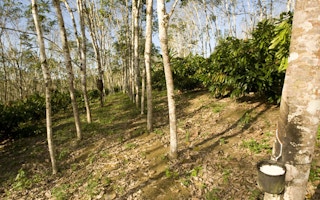Halcyon Agri Corporation Limited on Tuesday provided its first ever sustainability report to shareholders since being listed on the Catalist board of the Singapore Exchange (SGX) earlier this year.
To continue reading, subscribe to Eco‑Business.
There's something for everyone. We offer a range of subscription plans.
- Access our stories and receive our Insights Weekly newsletter with the free EB Member plan.
- Unlock unlimited access to our content and archive with EB Circle.
- Publish your content with EB Premium.
The sustainability report is also the first for a natural rubber processor, indicating a significant milestone for both the company and industry.
Globally, the natural rubber industry accounts for US$33 billion in business per year. Natural rubber, which the International Energy Centre deemed as the ‘greener’ option to synthetic rubber, is used predominantly for tires needed by the international automotive industry.
Demand, Halcyon stressed, is high. The industry is the second largest agribusiness after oil palm. Similar to the contentious crop that was a recent focus of environmental groups due to the Singapore-Malaysia haze caused by unsustainable land clearing methods, the cultivation of rubber also contributes to environmental degradation, according to the latest Yale Environment 360 report. It cited a 2009 study by Alan D. Ziegler, a geography professor at the National University of Singapore, stating that switching to plantation monocultures are linked to “erosion, increased stream sedimentation, accelerated pesticide use and declining water quality.”
Halcyon, however, operates in the midstream of the natural rubber supply chain through its three main business units on purchasing and risk management, processing, and investment. The firm is not involved in the actual farming or rubber plantations.
Still, Robert Meyer, company executive chairman and chief executive officer, said in the report: “We also need to be conscious of, and committed to, improving our upstream stakeholder engagement. Even if contact to date with rubber farmers has been limited, we need to recognise our ability to play an influential role in advocating sustainability issues.”
As such, it was the firm’s stakeholder relationships that Halcyon started to review first on its path to sustainability. After which and exploring relevant issues to the business, the company conducted a sustainability assessment in middle of 2011 and noted six strategic priorities that have an impact on the firm and industry. These are adherence to customer requirements and quality standards, production efficiency, environmental compliance, staff welfare, staff health and safety and good housekeeping.
One of the goals pertaining to environmental compliance that Halcyon wants to accomplish within the year is acquiring the ISO14001 certification or the international standard for environmental management.
Currently, its two processing plants in Palembang in Sumatra, Indonesia are ISO9001-certified, which stands for quality systems. It is there that Halcyon processes rubber slabs sourced and bought from local suppliers before exporting to the 20 leading tire manufacturers across the world.
Meyer said, “We need to take into account that our international customers are increasingly demanding responsibly managed supply chains. That provides additional pressure on us as a supplier, but it also reinforces our commitment to do things right by the environment and society, to be more productive and sustainable in our operations.”
As a result, the Halcyon Sustainability Report was made following the Global Reporting Initiative’s (GRI) 3.1 Reporting Guidelines and the SGX Guide on Sustainability Reporting for Listed Companies.
Halycon Agri Corporation also intends to improve water usage through conservation and reuse, as well shift to energy efficient technologies as it progresses its sustainabality efforts.
For a copy of the full report, download here.










